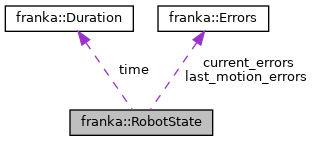 |
libfranka
0.8.0
FCI C++ API
|
 |
libfranka
0.8.0
FCI C++ API
|
Describes the robot state. More...
#include <robot_state.h>

Public Attributes | |
| std::array< double, 16 > | O_T_EE {} |
| \(^{O}T_{EE}\) Measured end effector pose in base frame. More... | |
| std::array< double, 16 > | O_T_EE_d {} |
| \({^OT_{EE}}_{d}\) Last desired end effector pose of motion generation in base frame. More... | |
| std::array< double, 16 > | F_T_EE {} |
| \(^{F}T_{EE}\) End effector frame pose in flange frame. More... | |
| std::array< double, 16 > | F_T_NE {} |
| \(^{F}T_{NE}\) Nominal end effector frame pose in flange frame. More... | |
| std::array< double, 16 > | NE_T_EE {} |
| \(^{NE}T_{EE}\) End effector frame pose in nominal end effector frame. More... | |
| std::array< double, 16 > | EE_T_K {} |
| \(^{EE}T_{K}\) Stiffness frame pose in end effector frame. More... | |
| double | m_ee {} |
| \(m_{EE}\) Configured mass of the end effector. | |
| std::array< double, 9 > | I_ee {} |
| \(I_{EE}\) Configured rotational inertia matrix of the end effector load with respect to center of mass. | |
| std::array< double, 3 > | F_x_Cee {} |
| \(^{F}x_{C_{EE}}\) Configured center of mass of the end effector load with respect to flange frame. | |
| double | m_load {} |
| \(m_{load}\) Configured mass of the external load. | |
| std::array< double, 9 > | I_load {} |
| \(I_{load}\) Configured rotational inertia matrix of the external load with respect to center of mass. | |
| std::array< double, 3 > | F_x_Cload {} |
| \(^{F}x_{C_{load}}\) Configured center of mass of the external load with respect to flange frame. | |
| double | m_total {} |
| \(m_{total}\) Sum of the mass of the end effector and the external load. | |
| std::array< double, 9 > | I_total {} |
| \(I_{total}\) Combined rotational inertia matrix of the end effector load and the external load with respect to the center of mass. | |
| std::array< double, 3 > | F_x_Ctotal {} |
| \(^{F}x_{C_{total}}\) Combined center of mass of the end effector load and the external load with respect to flange frame. | |
| std::array< double, 2 > | elbow {} |
| Elbow configuration. More... | |
| std::array< double, 2 > | elbow_d {} |
| Desired elbow configuration. More... | |
| std::array< double, 2 > | elbow_c {} |
| Commanded elbow configuration. More... | |
| std::array< double, 2 > | delbow_c {} |
| Commanded elbow velocity. More... | |
| std::array< double, 2 > | ddelbow_c {} |
| Commanded elbow acceleration. More... | |
| std::array< double, 7 > | tau_J {} |
| \(\tau_{J}\) Measured link-side joint torque sensor signals. More... | |
| std::array< double, 7 > | tau_J_d {} |
| \({\tau_J}_d\) Desired link-side joint torque sensor signals without gravity. More... | |
| std::array< double, 7 > | dtau_J {} |
| \(\dot{\tau_{J}}\) Derivative of measured link-side joint torque sensor signals. More... | |
| std::array< double, 7 > | q {} |
| \(q\) Measured joint position. More... | |
| std::array< double, 7 > | q_d {} |
| \(q_d\) Desired joint position. More... | |
| std::array< double, 7 > | dq {} |
| \(\dot{q}\) Measured joint velocity. More... | |
| std::array< double, 7 > | dq_d {} |
| \(\dot{q}_d\) Desired joint velocity. More... | |
| std::array< double, 7 > | ddq_d {} |
| \(\dot{q}_d\) Desired joint acceleration. More... | |
| std::array< double, 7 > | joint_contact {} |
| Indicates which contact level is activated in which joint. More... | |
| std::array< double, 6 > | cartesian_contact {} |
| Indicates which contact level is activated in which Cartesian dimension \((x,y,z,R,P,Y)\). More... | |
| std::array< double, 7 > | joint_collision {} |
| Indicates which contact level is activated in which joint. More... | |
| std::array< double, 6 > | cartesian_collision {} |
| Indicates which contact level is activated in which Cartesian dimension \((x,y,z,R,P,Y)\). More... | |
| std::array< double, 7 > | tau_ext_hat_filtered {} |
| \(\hat{\tau}_{\text{ext}}\) External torque, filtered. More... | |
| std::array< double, 6 > | O_F_ext_hat_K {} |
| \(^OF_{K,\text{ext}}\) Estimated external wrench (force, torque) acting on stiffness frame, expressed relative to the base frame. More... | |
| std::array< double, 6 > | K_F_ext_hat_K {} |
| \(^{K}F_{K,\text{ext}}\) Estimated external wrench (force, torque) acting on stiffness frame, expressed relative to the stiffness frame. More... | |
| std::array< double, 6 > | O_dP_EE_d {} |
| \({^OdP_{EE}}_{d}\) Desired end effector twist in base frame. More... | |
| std::array< double, 16 > | O_T_EE_c {} |
| \({^OT_{EE}}_{c}\) Last commanded end effector pose of motion generation in base frame. More... | |
| std::array< double, 6 > | O_dP_EE_c {} |
| \({^OdP_{EE}}_{c}\) Last commanded end effector twist in base frame. More... | |
| std::array< double, 6 > | O_ddP_EE_c {} |
| \({^OddP_{EE}}_{c}\) Last commanded end effector acceleration in base frame. More... | |
| std::array< double, 7 > | theta {} |
| \(\theta\) Motor position. More... | |
| std::array< double, 7 > | dtheta {} |
| \(\dot{\theta}\) Motor velocity. More... | |
| Errors | current_errors {} |
| Current error state. | |
| Errors | last_motion_errors {} |
| Contains the errors that aborted the previous motion. | |
| double | control_command_success_rate {} |
| Percentage of the last 100 control commands that were successfully received by the robot. More... | |
| RobotMode | robot_mode = RobotMode::kUserStopped |
| Current robot mode. | |
| Duration | time {} |
| Strictly monotonically increasing timestamp since robot start. More... | |
Describes the robot state.
| std::array<double, 6> franka::RobotState::cartesian_collision {} |
Indicates which contact level is activated in which Cartesian dimension \((x,y,z,R,P,Y)\).
After contact disappears, the value stays the same until a reset command is sent.
| std::array<double, 6> franka::RobotState::cartesian_contact {} |
Indicates which contact level is activated in which Cartesian dimension \((x,y,z,R,P,Y)\).
After contact disappears, the value turns to zero.
| double franka::RobotState::control_command_success_rate {} |
Percentage of the last 100 control commands that were successfully received by the robot.
Shows a value of zero if no control or motion generator loop is currently running.
Range: \([0, 1]\).
| std::array<double, 2> franka::RobotState::ddelbow_c {} |
Commanded elbow acceleration.
The values of the array are:
| std::array<double, 7> franka::RobotState::ddq_d {} |
\(\dot{q}_d\) Desired joint acceleration.
Unit: \([\frac{rad}{s^2}]\)
| std::array<double, 2> franka::RobotState::delbow_c {} |
Commanded elbow velocity.
The values of the array are:
| std::array<double, 7> franka::RobotState::dq {} |
\(\dot{q}\) Measured joint velocity.
Unit: \([\frac{rad}{s}]\)
| std::array<double, 7> franka::RobotState::dq_d {} |
\(\dot{q}_d\) Desired joint velocity.
Unit: \([\frac{rad}{s}]\)
| std::array<double, 7> franka::RobotState::dtau_J {} |
\(\dot{\tau_{J}}\) Derivative of measured link-side joint torque sensor signals.
Unit: \([\frac{Nm}{s}]\)
| std::array<double, 7> franka::RobotState::dtheta {} |
\(\dot{\theta}\) Motor velocity.
Unit: \([rad]\)
| std::array<double, 16> franka::RobotState::EE_T_K {} |
\(^{EE}T_{K}\) Stiffness frame pose in end effector frame.
Pose is represented as a 4x4 matrix in column-major format.
See also K frame.
| std::array<double, 2> franka::RobotState::elbow {} |
Elbow configuration.
The values of the array are:
| std::array<double, 2> franka::RobotState::elbow_c {} |
Commanded elbow configuration.
The values of the array are:
| std::array<double, 2> franka::RobotState::elbow_d {} |
Desired elbow configuration.
The values of the array are:
| std::array<double, 16> franka::RobotState::F_T_EE {} |
| std::array<double, 16> franka::RobotState::F_T_NE {} |
| std::array<double, 7> franka::RobotState::joint_collision {} |
Indicates which contact level is activated in which joint.
After contact disappears, the value stays the same until a reset command is sent.
| std::array<double, 7> franka::RobotState::joint_contact {} |
Indicates which contact level is activated in which joint.
After contact disappears, value turns to zero.
| std::array<double, 6> franka::RobotState::K_F_ext_hat_K {} |
\(^{K}F_{K,\text{ext}}\) Estimated external wrench (force, torque) acting on stiffness frame, expressed relative to the stiffness frame.
See also K frame. Unit: \([N,N,N,Nm,Nm,Nm]\).
| std::array<double, 16> franka::RobotState::NE_T_EE {} |
\(^{NE}T_{EE}\) End effector frame pose in nominal end effector frame.
Pose is represented as a 4x4 matrix in column-major format.
| std::array<double, 6> franka::RobotState::O_ddP_EE_c {} |
\({^OddP_{EE}}_{c}\) Last commanded end effector acceleration in base frame.
Unit: \([\frac{m}{s^2},\frac{m}{s^2},\frac{m}{s^2},\frac{rad}{s^2},\frac{rad}{s^2},\frac{rad}{s^2}]\).
| std::array<double, 6> franka::RobotState::O_dP_EE_c {} |
\({^OdP_{EE}}_{c}\) Last commanded end effector twist in base frame.
Unit: \([\frac{m}{s},\frac{m}{s},\frac{m}{s},\frac{rad}{s},\frac{rad}{s},\frac{rad}{s}]\).
| std::array<double, 6> franka::RobotState::O_dP_EE_d {} |
\({^OdP_{EE}}_{d}\) Desired end effector twist in base frame.
Unit: \([\frac{m}{s},\frac{m}{s},\frac{m}{s},\frac{rad}{s},\frac{rad}{s},\frac{rad}{s}]\).
| std::array<double, 6> franka::RobotState::O_F_ext_hat_K {} |
\(^OF_{K,\text{ext}}\) Estimated external wrench (force, torque) acting on stiffness frame, expressed relative to the base frame.
See also K frame. Unit: \([N,N,N,Nm,Nm,Nm]\).
| std::array<double, 16> franka::RobotState::O_T_EE {} |
\(^{O}T_{EE}\) Measured end effector pose in base frame.
Pose is represented as a 4x4 matrix in column-major format.
| std::array<double, 16> franka::RobotState::O_T_EE_c {} |
\({^OT_{EE}}_{c}\) Last commanded end effector pose of motion generation in base frame.
Pose is represented as a 4x4 matrix in column-major format.
| std::array<double, 16> franka::RobotState::O_T_EE_d {} |
\({^OT_{EE}}_{d}\) Last desired end effector pose of motion generation in base frame.
Pose is represented as a 4x4 matrix in column-major format.
| std::array<double, 7> franka::RobotState::q {} |
\(q\) Measured joint position.
Unit: \([rad]\)
| std::array<double, 7> franka::RobotState::q_d {} |
\(q_d\) Desired joint position.
Unit: \([rad]\)
| std::array<double, 7> franka::RobotState::tau_ext_hat_filtered {} |
\(\hat{\tau}_{\text{ext}}\) External torque, filtered.
Unit: \([Nm]\).
| std::array<double, 7> franka::RobotState::tau_J {} |
\(\tau_{J}\) Measured link-side joint torque sensor signals.
Unit: \([Nm]\)
| std::array<double, 7> franka::RobotState::tau_J_d {} |
\({\tau_J}_d\) Desired link-side joint torque sensor signals without gravity.
Unit: \([Nm]\)
| std::array<double, 7> franka::RobotState::theta {} |
\(\theta\) Motor position.
Unit: \([rad]\)
| Duration franka::RobotState::time {} |
Strictly monotonically increasing timestamp since robot start.
Inside of control loops time_step parameter of Robot::control can be used instead.
 1.8.13
1.8.13